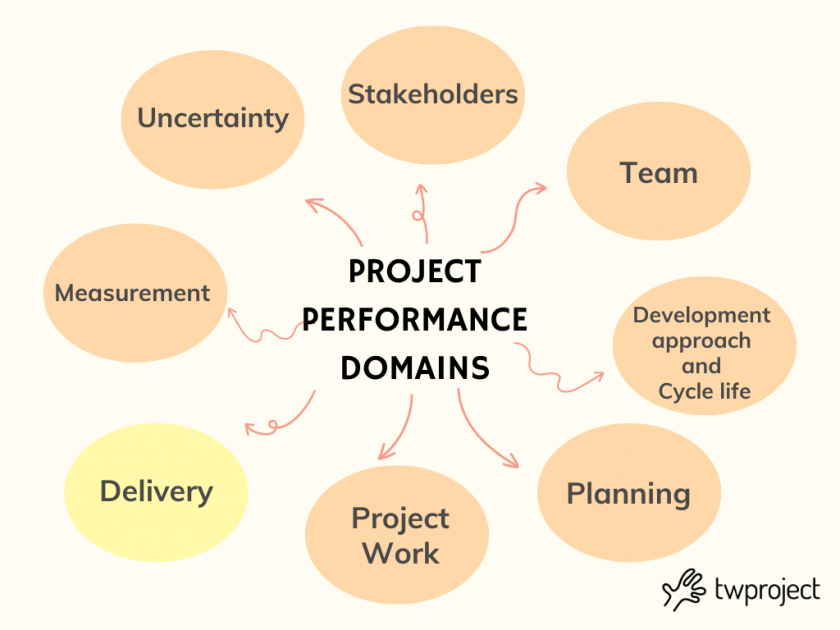The Delivery performance domain pertains to everything the project will deliver.
This article will discuss in detail what it is, its elements, and its connection to the other performance domains according to the seventh edition of the PMBOK.
CONTENT
What is the Delivery Performance Domain?

The key elements of the delivery performance domain are scope and quality.
Scope refers to what the project must deliver, and quality, conversely, to the performance standards or levels the deliverables must meet.
In predictive projects, a scope can be predefined during the planning phase, and change control practices are applied during the il project life cycle.
Whereas in adaptive approaches, a new emerging scope is always welcome.
The delivery performance domain involves delivering the project scope according to quality requirements.
This awareness leads to stakeholder satisfaction.
The main sections of the delivery performance domain are:
- Delivery of value: All projects yield an output or delivery at the end, which must generate value for the organization.
- Requirements elicitation: It is about collecting and revealing requirements by using a variety of different methods.
- Scope definition: Scope definition is an endless process until the end of the project.
- Quality: Apart from the delivery requirements, quality is the performance level to be achieved.
- Suboptimal outcomes: many projects may fail to deliver expected outputs and, therefore, yield suboptimal results. This is a natural part of the delivery performance domain.
Let’s explore these elements in detail:
Delivery of value
Projects that call for a release of deliverables throughout their project lifecycle can begin to provide value to stakeholders over their entire duration.
Conversely, projects that involve a final delivery of deliverables will generate value only after distribution.
No matter the type of delivery, business value can continue well after the outputs are released.
A business case document will include a forecasted business value projection for the project, which is often used for stakeholder approval at the start of work.
Requirements elicitation
A requirement is a condition or capability that must be present in a product, service, or result to meet a business need.
To elicit means to pull out or bring out.
Here, it means collecting and analyzing requirements to ensure satisfactory project results.
Specifically, the requirements must be:
-
- Clear
- Concise
- Verifiable
- Coherent
- Complete
- Traceable
Scope definition
As the requirements are identified, the scope that will meet them is also defined.
The scope is the sum of the products, services, and outputs to be delivered by the project.
This can be defined by different strategies, such as by using a work breakdown structure –WBS -that allows for a detailed representation of the required activities.
Alternatively, the scope can be devised by identifying the project’s themes in a roadmap.
Quality
Quality dictates the levels of performance or delivery that must be achieved.
However, ensuring quality comes at a cost, from training to auditing, which makes it necessary to balance quality requirements with their associated costs.
The cost of quality methodology-COQ-is used to find this balance and consists of four cost categories:
-
- Prevention: To guarantee a product free of defects and faults.
- Evaluation: Incurred to determine the degree of compliance with quality requirements.
- Internal failure: Involves finding and correcting defects before the customer receives the product.
- External failure: Defects discovered after the customer has received the product and it needs repair.
Suboptimal outcomes
All projects seek to deliver results, although some may fail or produce suboptimal results.
The reasons behind this may differ; for example, an organization might attempt to create an innovative product, such as a completely new technology.
This requires a deliberate investment with an uncertain outcome.
Alternatively, some projects might provide suboptimal results because the opportunity is past or competitors have arrived first.

The delivery performance domain and interactions with other performance domains
The Delivery Performance Domain is not standalone but closely related to and interacts with other performance domains.
One of the most prominent connections is with the Planning Performance Domain since planning determines how and when results will be produced and delivered. How often and by what nature deliverables are delivered depends on how work is structured in these domains.
While the Delivery Performance Domain focuses primarily on progress toward business objectives and delivery of value, it is paramount to consider how it fits within a more extensive network of operations and goals.
This interconnection ensures that deliverables are high-quality and meet stakeholder needs and expectations, resulting in a well-executed project that is integrated into the overall business context.
In conclusion, the Delivery Performance Domain is a pivotal element in project management.
It not only drives the operational phases of a project’s output but also acts as a compass to ensure that the results meet the needs and expectations of stakeholders.
Understanding and effectively implementing every aspect of this domain, from value delivery to scope definition, from quality to possible suboptimal outcomes, are critical to the success of any project.
By integrating these practices with tight coordination with other performance domains, project managers can ensure they deliver high-value outcomes that benefit the entire organization.


